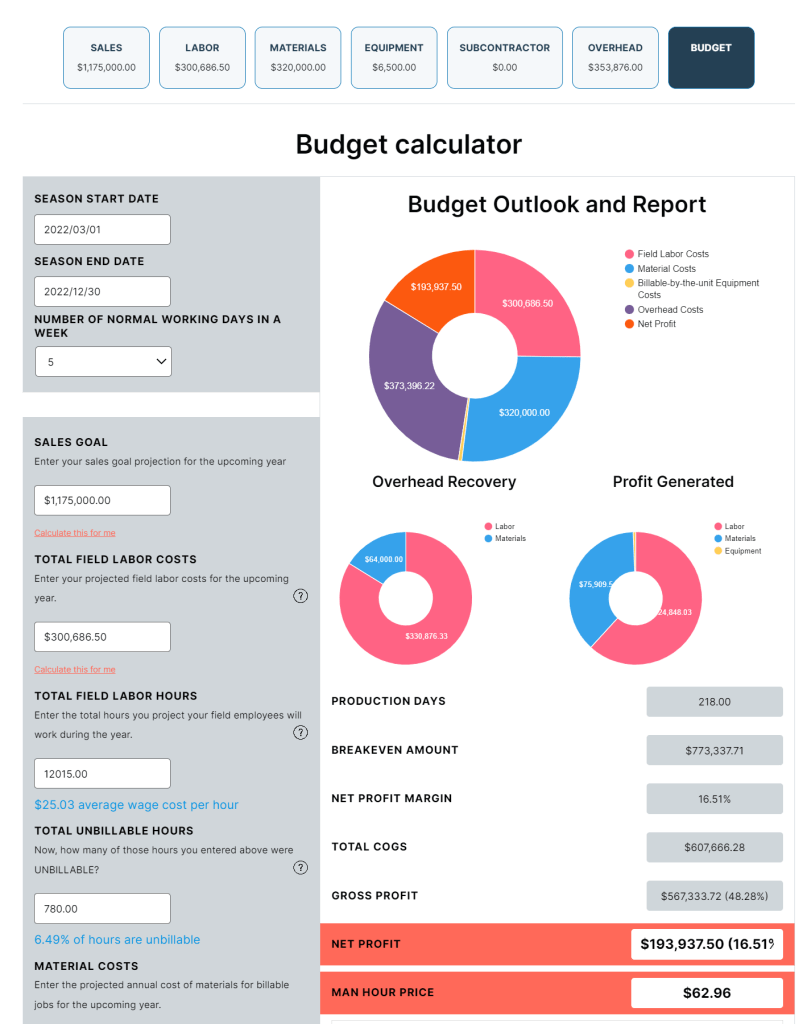Charging What You’re Worth

Are you charging what you’re worth?
You’re working like an animal, 80 hours a week, charging just enough to pay everybody but yourself, you glance at your checking account balance, and simply put, you’re not making it. Payroll is due next week, taxes, and vendor bills are rolling in…
Ever been there?
Maybe you’re there now…
I have a friend who has been in the industry for decades. He is an incredibly hard worker, humble, and aims to please, and if anyone should be successful, he should be. He does great work. Cares about his guys. His customers love him. How could he not be successful?
I spent a few hours with him on Friday, and it really boiled down to one thing.
Self-limiting beliefs on what he was worth. What he could charge. What he could pay himself.
He was charging $45/hr. And not really even paying himself. (He couldn’t. There was no money left to pay himself.)
Before we even sat down to build his budget, I knew he wasn’t charging nearly enough.
The math will reveal what you should be charging
But… after helping hundreds of landscape business owners build their budgets, I’ve learned the best way to help overcome the mindset of “I can’t be charging $X” is to not argue the point, but just quietly put all the expenses into a budget, and let the math reveal itself. Very few people will try to argue the results of math. 2+2 always = 4 . (Although believe it or not, I’ve run into a few that try to argue it, haha)
We spent a little over an hour plugging all his expenses into our free budgeting tool. He did have good records from his Quickbooks, which made plugging his expenses in a lot easier. We ran into a couple of things where we had to do some quick math and educated guesses on just how much his expense was on some things. For example, how many overtime hours his team worked in a season.
As we were plugging things in, we also made sure to add a few things that we wished were true, like that he could replace a truck or two, and that he would pay himself as an owner a proper salary. We were employing the tactic of “budget for the business you want to have, not the business you are now.” I like to use this tactic, and then if I can still sell the jobs at the prices that my budget (with those “I wish” expenses) dictated, that’s my permission to go spend that money and get those things for the business.
When we were all done, we arrived at the exciting moment of trepidation when we clicked on the last tab of the budget tool, where it revealed the outcome.
Was this business going to be profitable with all the expenses we entered?
What did my man-hour price have to be?
What did my markup have to be to cover all my overhead?
We clicked…. and oo la la! All the answers lay there in front of us.

*just an example, not his actual budget ☝️
His results?
To cover his cost of goods, and his overhead expenses, pay himself, and replace his trucks and equipment when he needed to, he had to be charging $68/hr.
Now that number was his floor. You see the budget tells you what your floor is, you can not charge less than that number. But you can always be charging more. The market is the only ceiling. As long as you can sell the job, you still haven’t encountered your ceiling.
Now, here’s what happened next. First, he was relieved. Here was the answer. No more wondering what he had to be charging to truly cover his costs. Then next… the fear factor. Can I really be charging that? My favorite customer(s) that I’ve been working with for years, what will they say?
I noticed his mind was really fixated on the “dollar per man hour” number. So…. next I showed him the free estimating calculator on our website, which doesn’t really even show the man-hour price as you estimate, it just shows you the total price. It basically just asks you to plug in your material costs and how many man-hours you think it’ll take to do the job, and it does the math based on your budget and shows you the final price that you would have to charge.
We pulled it right up on his phone, I showed him how to use it, and he saved the link on his phone to make it easy to come back to.
We wrapped things up and called it a day.
The next morning I got a text: 25k job sold off the calculator. 10 minutes , approved and scheduled. Thank you!
Now that’s what I’m talking about 😎.
It seemed like the simplicity of just plugging in expenses and hours, and getting the final number really helped him. It was easy to get hung up on that “dollar per hour” number, and fight the head trash that “I’m not worth that” or “Mrs. Jones will never pay that.” or “If I’m not there on site, I can’t charge that much for just my new guys to be there”.
Your results?
So, if you are wondering if you’re charging what you’re worth, just use those free calculators above. Find out!
I need to wrap this article up, but my mission is to find as many people as possible that need this type of help. Unlock self-limiting beliefs, let the math speak, and help as many landscape entrepreneurs to start charging what they really need to be charging. Help as many landscape companies as possible thrive, not survive.
If you need a hand, or you have an experience or comment to share, hit me up in the comments.
I wanna hear it.

Weston Zimmerman
CEO and co-founder
See SynkedUP in action
Related Articles
Business Hard? Choose Your Hard
Business Hard? Choose Your Hard Is business feeling hard right now? Maybe you’re seeing leads dry up. Maybe you’re having...
Know Your Numbers – I Know it’s Bad, I Don’t Want to Look – What Next?
Know your numbers – I know it’s bad, I don’t want to look – what next? You know you should...
Final Chance To Register for the Contractor Summit!
The Power of Following Up on Proposals Ever have that sneaking suspicion that you lost work because you forgot to...
The Power of Following Up on Proposals
The Power of Following Up on Proposals Ever have that sneaking suspicion that you lost work because you forgot to...
Incentive Plans for Your Crew
Incentive Plans for Your Crew I’ve seen a couple posts this past week where contractors were asking about how to...
Building a system for your estimating process
How Long Does It Take To Close A Proposal On Average? Average Proposal Have you ever sent a proposal, not...
How Long Does It Take To Close A Proposal On Average?
How Long Does It Take To Close A Proposal On Average? Average Proposal Have you ever sent a proposal, not...
Your Crew Going Over Estimated Hours Regularly?
Your Crew Going Over Estimated Hours Regularly Estimated Hours Let’s say you’ve estimated and installed your own jobs as the...
2nd Mistake Contractors Make When Estimating Labor
2nd Mistake Contractors Make When Estimating Labor for Jobs The 2nd mistake in estimating Last week I started a series...
Top Mistake Contractors Make When Estimating Labor on Jobs
Top Mistake Contractors Make When Estimating Labor on Jobs Estimating Jobs It’s frustrating when you feel you’re doing everything right,...











6 Responses
Good Stuff Weston!
I’m thinking what you’ve created could benefit me and my operation greatly!
Thanks Eric! Happy to talk man! Hit me up, weston@synkedup.com or DM me on Instagram @synkedup
Great article, all soo true! We implemented this January and as a company we are really benefiting in every way!!
That’s fantastic Wyatt. I love hearing that. Congrats to you on investing into yourself, your team, and business. That’s a leap of faith many fear to take.
Interesting article, I enjoyed reading it, thank you.
I have been in the service industry for nearly 37 years. As a certified master stonemason, bricklayer, tile installer, hardscape designer & installer/landscape construction expert, as well as a concrete finisher, I found affluent people are notoriously cheap.
Everyone wants to feel like they got a great deal, especially wealthy people. It’s us middle-class folk who arex willing to pay the going rate.
With so many illegal contractors flooding the market over the past 20 years, some of whom do great work at a seriously discounted rate, I learned that inexperienced sales people worry too much about the other guys prices.
This article rings true because the total cost of labor & materials are about the same for all contractors in your area. No one is getting professionals to work for less & materials cost what they cost. The math does not lie.
If you have competitors willing to do a project for considerably less than you are coming up with, only one or two reasons can explain why. 1) The other guy is skipping steps & or buying inferior materials or, 2) the other guy does is not providing insurance, licensing, pay taxes, workers comp & all of the overhead you have.
Maybe a customer doesn’t care if you are simply mowing their lawn & or providing horticulture however, if your customer is asking for services that require skilled professionals, lay out your numbers & compare apples to apples.
America is flooded with companies running their business legally. All of these businesses will have a large nut to cover each month.
Successful companies like Old Colony Masons will take the time to price each project correctly & concisely. Know what it is going to cost you to do every job before you provide your free estimate.
Know what your overhead is costing for rent, office staff, insurance, trucks, equipment, fuel, even paper for the copy machine. Include everything, paperclips cost money.
Know your monthly operating cost cold and divide it by the number of jobs you do each month.
Customers have to pay for your total expenses plus whatever you think your worth. That is the only number that fluctuates.
Too many contractors take on projects that ultimately cost then money in the end. They say 9 out of 10 contractors will not survive 5+ years in business.
The reason for this is usually one of two three things, 1) Improve your closing ratio through education, not by giving the store away. 2) Do not price jobs by the square foot. Do the long Math on every project you bid on. 3) Companies sell price, not service.
Fact; You will not lose a project over a few hundred dollars.
Do you want to stay in business long term? Of course you do, and therefore, add your material cost, labor cost, monthly operating cost to find your break even amount. Business 101 taught me that a company smaller than say, Walmart must make at least 30% to survive.
Remember, your monthly operating cost has to include all expenses not categorized under materials or labor, including your own weekly salary.
How to determine your weekly salary? A lot goes into this calculation but for newer company owners, give yourself a low end living wage. $1500 per week for example.
Do not worry about your weekly salary, that is something your employees should be thinking about. You are only trying to survive at this point.
The most important aspect of job pricing is to ensure you will have the ability to repair & replace equipment, trucks, tools, etc.
Now that your salary is calculated into your monthly overhead, you know what materials and labor will cost per job, add the numbers plus 33% for your business.
If you run efficiently, you will have a nest egg saved to give yourself a yearly bonuses.
Do not try to take as much money possible from job to job. Assigning yourself a weekly salary & worry about funding your business on a quarterly basis.
Each customer must pay their share of your monthly overhead. The number is surprisingly low if you have steady customers.
No, we cannot simply add a random number for profit. Do the math, lay it out for your customer to see and they will conclude that you know what your doing and that your estimate is accurate & reliable.
Thus proven formula does not work well for projects that require no special skill or equipment. If a customer can do a job themselves, price alone accounts for 90% of their decision making.
A customer will pay skilled labor a premium if they know that you will personally take care of every detail. A customer is buying the salesperson they worked with more than anything else. Earn your customers trust. Your fiduciary responsibility is to your customers & a low ball estimate is not helping your customer in the long run.
I hope my experience will help some of your readers understand how to price jobs correctly. As business owners, we must think about & plan in 3 month, yearly & 5 year increments.
The low ball companies come & go, often to court. Haha. Do right by your customer by pricing their project responsibly. Your customers expect you to make money, they just want a fair price based on facts, not guesses.
Jay Casey
Old Colony Masons
Thanks for sharing your experience and insight Jay. I know that took some time. It’s when folks like you who have walked this path before, reach back and lift someone else up, that this world becomes a better place. Appreciate it.